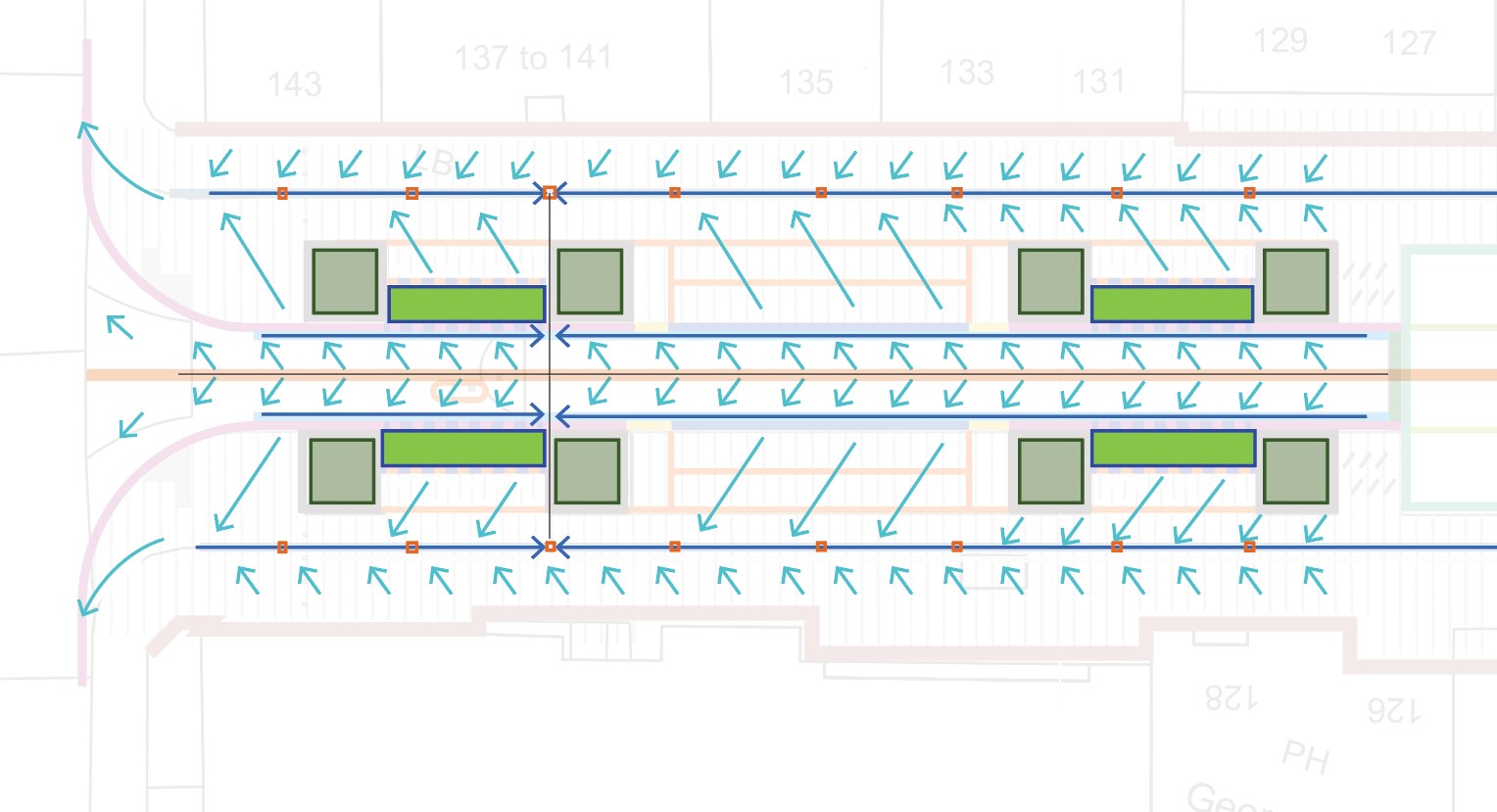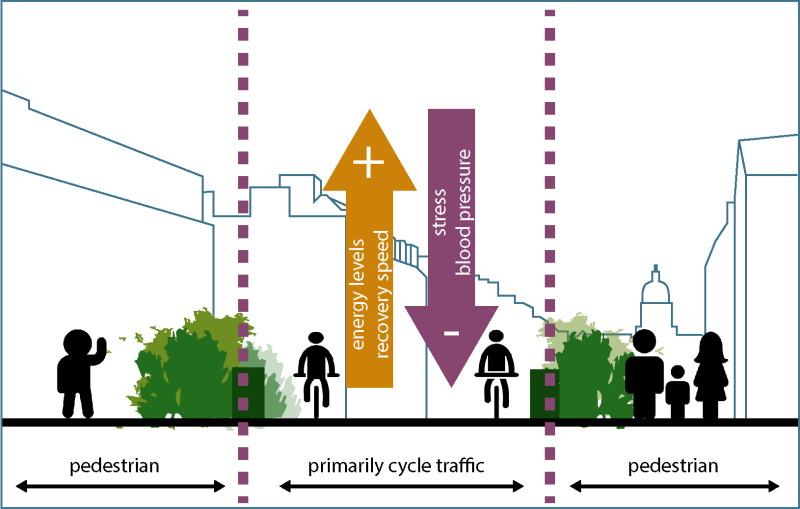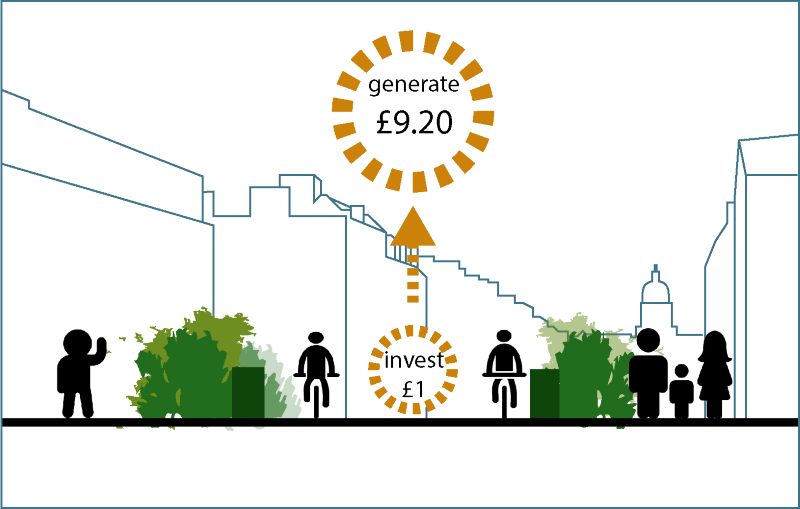Environment

Sustainability is central to the design and the proposals align with Council strategies and plans including
- 2030 Climate Strategy
- Vision for Water Management in the City of Edinburgh
- Edinburgh Nature Network
- Climate Ready Edinburgh Plan 2024-2030
These documents set out the importance of the incorporation of green and blue infrastructure, and support Edinburgh's strategic goals for air quality, climate resilience and sustainability.
Significantly reducing vehicle access will encourage more people to choose sustainable transport instead of the car. While introducing a variety of suitable plants and hedging will help to increase local biodiversity.
Investment in well-planned improvements to the outdoor space, including landscaped seating areas is shown to attract more people to visit and spend time in the area.
Good for people: Urban greening and planting for relaxation and enjoyment
Spending time near nature improves physical and mental health by increasing energy levels and lowering stress and blood pressure. It also aids recovery from illness, therefore reducing healthcare costs.
Read about how nature benefits mental health according to Mind, how investing in nature is an investment in the NHS, Environment Agency Chief Executive - GOV.UK and how nature is prescribed to help health (rspb.org.uk)
Street greening can also increase safety as planting creates safer walking environments by clearly defining the space available for walking and wheeling.
Good for the economy: Urban greening is good for local business
Commercial streets with street greening show higher income streams than those without as customers are likely to spend more time and money in retail areas with street greening.
We commissioned Rettie and Co to carry out an Economic Impact Assessment looking at the potential economic impact on the local economy. The report concludes that full investment in the proposals will generate a potential net Gross Value Added benefit of £95 million. The full Economic Impact Assessment is availabe to read as appendix 4 in the Transport and Environment Committee report.
Well-planned improvements to public spaces within town and city centres have been shown to boost commercial trading by up to 40%. Read more about what Living Streets has to say about the pedestrian pound.
Investments in walking environments can increase the value of residential and commercial properties, and of rental income. Read the Living Streets report on investing in the walking environment.
Good for the environment: Urban greening combats flooding
Soft landscaping including trees and plants reduces the impact of heavy rain and floods, making Sustainable Urban Drainage Systems more effective, which absorbs carbon, helps filter out air pollutants and can help improve mental wellbeing
Planting regulates water flow, improves water quality, and reduces urban water run-off. Read about urban rain gardens.

Sustainable urban drainage
Street greening provides an opportunity to increase sustainable drainage. The aim is to reduce the volume and speed of rainwater entering and potentially overwhelming urban drainage systems, which can cause flooding.
Water is held, often in soft, greened areas, where it can infiltrate the ground and re-enter the freshwater cycle. The rate at which surface water drainage re-enters the freshwater cycle is slowed down by the planting, so reduces the risk of flooding.
Water is also held to keep plants watered during periods of drought to reduce maintenance requirements.
Greening within the proposals
Previous consultation showed a desire for street planting within George Street.
The proposals provide a coherent approach to incorporating greenery along the street, with appropriate plants and trees, that will be visually appealing and add colour, seasonal variation and enhance biodiversity.
We have formed a partnership with Edinburgh World Heritage, Royal Botanic Garden Edinburgh and consultants AtkinsRealis to make sure we have a high-quality, resilient planting palette for George Street that respects the historic environment whilst provides the benefits of urban greening.
Planting palettes will be tested and monitored at a site in the Royal Botanic Garden Edinburgh before construction to make sure their suitability and success while complementing the UNESCO World Heritage Site in terms of line, unity, scale, pattern, proportion and form.
Greening plans include
- planting
- rain garden soil
- permeable liner
- natural aquifer blocks
- perforated pipe
- impermeable liner
A number of drainage elements will be incorporated into the proposals including
- rain gardens
- linear channels on pavements and central spaces

Our plan for a sustainable urban drainage system (SUDs)
A sustainable urban drainage strategy has been developed for the street which
- integrates with the unique heritage
- helps to make the street more adaptable to the impacts of climate change and helps us reach our goal of being net zero carbon by 2030
- is practical to maintain
- aligns with the Edinburgh Water Vision

Key
- planting
- rain garden soil
- permeable liner
- natural aquifer blocks
- perforated pipe
- impermeable liner
A number of drainage elements will be incorporated into the proposals including:
- permeable paving
- rain gardens
- linear channels and slot drains on pavements and central squares
- kerb drainage units to capture run off from the cycle street.


